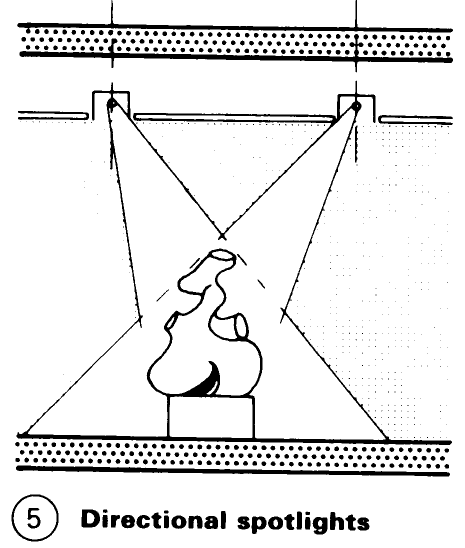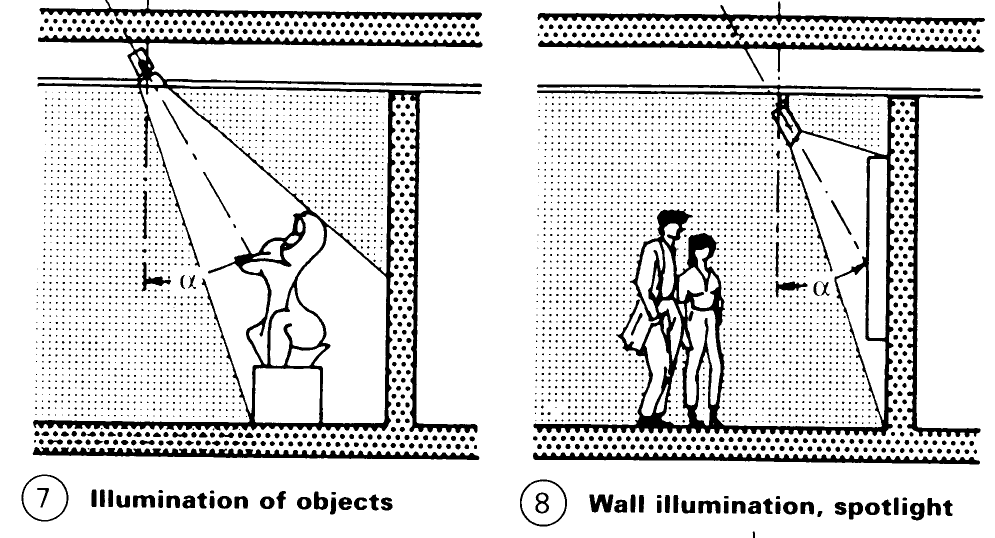Forms of Lighting for Internal Areas. Geometry of Lighting Arrangements
Direct, symmetrical lighting – (1) is preferred for all general illumination of work rooms, meeting rooms, rooms in public use and circulation zones. The required level of illumination can be achieved with relatively little electrical power: standard values for specific loadings are given on p. 147. When designing a lighting system, an angle of illumination between 70° and 90° should be tried first.

Downlights (wall floods, louvre lighting) - (2) can provide uniform wall illumination while the effect on the rest of the room is that of direct lighting. Wall floods on a power supply rail - (3) can also give uniform wall illumination over the required area, depending on the separation between the lamp and the wall; up to 500lx can be achieved. Fluorescent lamps and halogen filament lamps can also be used.


Wall floods for ceiling installation – (4) can be sited so as to provide low room light or illumination of one wall. These can also make use of halogen filament lamps and fluorescent lamps.

Downlighting with directed spotlights – (5) using a regular arrangement of lamps on the ceiling and swivelling reflectors can give different lighting levels in the room. Halogen filament lamps are most suitable, in particular those with low-voltage bulbs.

Indirect lighting (6) can give an impression of a bright room free of glare even at low lighting levels, although the room must be sufficiently high and careful ceiling design is needed to give the required luminance. Energy consumption in this form of lighting is up to three times higher than for direct lighting so combinations are often used (e.g. 70% direct, 30% indirect) providing the room height is adequate (h>3m) - (7). Fluorescent lamps are usually used in direct/indirect lighting, but they may also be combined with filament lamps.


Ceiling and floor floods – (8) - (9) are employed to illuminate ceiling and floor surfaces. They usually use halogen filament or fluorescent lamps, although high- pressure discharge lamps are also a possibility.


Wall lights – (10) are principally used for decorative wall lighting and can also incorporate special effects (e.g. using colour filters or prisms). To a limited extent, they can also be used for the illumination of ceilings or floors.

Wall floodlights and spotlights on power supply rails –(11) – (12) are particularly useful in sale rooms, exhibitions, museums and galleries. With wall floodlights, typical requirements are for vertical illumination levels of 50lx, 150lx or З00Іх; filament and fluorescent lamps are usually preferred. For spotlights, the basic light emission angles are 10° ('spot'), 30° ('highlight') and 90°('flood'). The angle of the light cone can be varied by passing the light through lenses (sculptured lenses, Fresnel lenses), and the spectrum of the light can be varied using UV and IR filters and colour filters. Shading can be arranged by means of louvres and anti-glare flaps.

Geometry of Lighting Arrangements. The spacing between light fittings and between the light fittings and the walls depends on the height of the room – (1) – (4).


The preferred incidence at which light strikes objects and wall areas is between 30° (optimum) and 40° - (5)-(9).



The shading angle of downward lighting lies between 30° (wide-angle lighting, adequate glare control) and 50° (narrow-angle lighting, high glare control) – (10), and between 30° and 40° in the case of louvred lighting.

Date added: 2023-01-01; views: 728;
